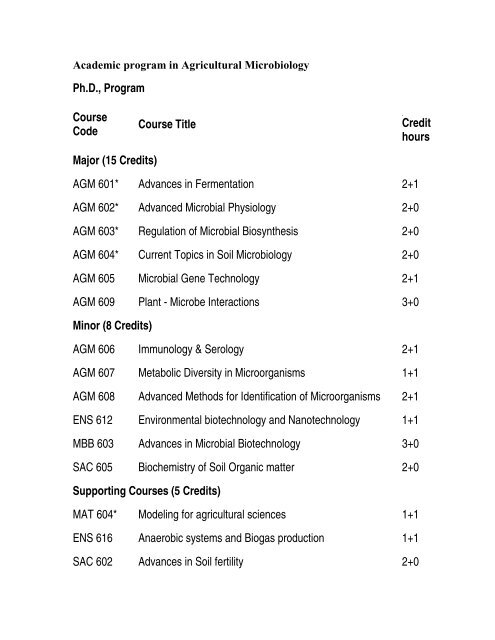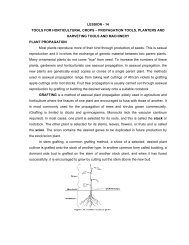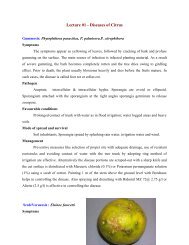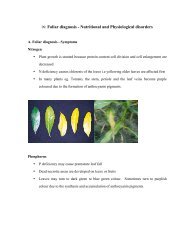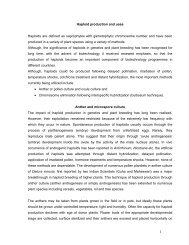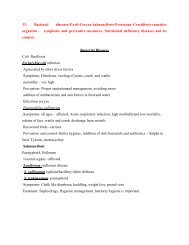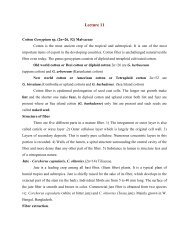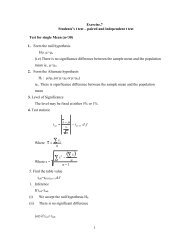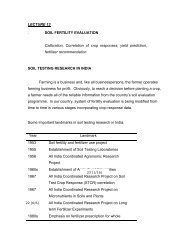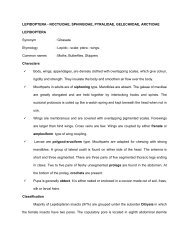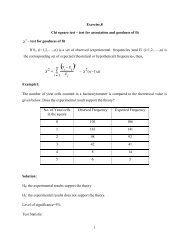Ph.D Programs in Agricultural Microbiology
Ph.D Programs in Agricultural Microbiology
Ph.D Programs in Agricultural Microbiology
Create successful ePaper yourself
Turn your PDF publications into a flip-book with our unique Google optimized e-Paper software.
Academic program <strong>in</strong> <strong>Agricultural</strong> <strong>Microbiology</strong><br />
<strong>Ph</strong>.D., Program<br />
Course<br />
Code<br />
Course Title<br />
Credit<br />
hours<br />
Major (15 Credits)<br />
AGM 601* Advances <strong>in</strong> Fermentation 2+1<br />
AGM 602* Advanced Microbial <strong>Ph</strong>ysiology 2+0<br />
AGM 603* Regulation of Microbial Biosynthesis 2+0<br />
AGM 604* Current Topics <strong>in</strong> Soil <strong>Microbiology</strong> 2+0<br />
AGM 605 Microbial Gene Technology 2+1<br />
AGM 609 Plant - Microbe Interactions 3+0<br />
M<strong>in</strong>or (8 Credits)<br />
AGM 606 Immunology & Serology 2+1<br />
AGM 607 Metabolic Diversity <strong>in</strong> Microorganisms 1+1<br />
AGM 608 Advanced Methods for Identification of Microorganisms 2+1<br />
ENS 612 Environmental biotechnology and Nanotechnology 1+1<br />
MBB 603 Advances <strong>in</strong> Microbial Biotechnology 3+0<br />
SAC 605 Biochemistry of Soil Organic matter 2+0<br />
Support<strong>in</strong>g Courses (5 Credits)<br />
MAT 604* Model<strong>in</strong>g for agricultural sciences 1+1<br />
ENS 616 Anaerobic systems and Biogas production 1+1<br />
SAC 602 Advances <strong>in</strong> Soil fertility 2+0
MBB 602 Advances <strong>in</strong> Genetic Eng<strong>in</strong>eer<strong>in</strong>g 3+0<br />
PFE 602 Advances <strong>in</strong> Food Process<strong>in</strong>g 3+0<br />
Sem<strong>in</strong>ar and Research<br />
AGM 691 Sem<strong>in</strong>ar I 0+1<br />
AGM 692 Sem<strong>in</strong>ar II 0+1<br />
AGM 699 Research 0+45<br />
* Compulsory courses<br />
1. MAJOR COURSES 1.1.AG - Advances M 601 <strong>in</strong> Fermentation (2+1)<br />
Objective<br />
<strong>in</strong>dustrially useful microorganisms<br />
To teach students reg<br />
<strong>in</strong>clud<strong>in</strong>g yeast technology.<br />
Unit I<br />
An -current overview status offerm fermentation entation <strong>in</strong>dustry.<br />
Fermentor designs, high performance bioreactors. Methods of<br />
fermentations, Fermentation k<strong>in</strong>etics- mass and energy transfer <strong>in</strong><br />
bioreactors. Instrumentaion and control <strong>in</strong> fermentors-onl<strong>in</strong>e<br />
measurements systems, Biosensors, computer application.<br />
Unit II<br />
Media for microbial fermentation: criteria <strong>in</strong> media formulation. An<br />
overview of downstream process<strong>in</strong>g.<br />
M icrobiology ofIn<br />
Unit III<br />
Screen<strong>in</strong>g for new m<br />
<strong>in</strong>dustrially important microbes and their genetic manipulations.Products<br />
from fermentation <strong>in</strong>dustries. Microbial production of health care products.<br />
Biocatalysts and bioprocess<strong>in</strong>g. Antibiotic fermentation research: Microbial<br />
transformations- steroid transformation-Microbial colourants.<br />
Unit IV<br />
metabolites. Treatment of biological wastes, microbial <strong>in</strong>oculants and<br />
enzymes for waste treatment-Value addition through microbial<br />
Recentdevelopm e
fermentation.<br />
Unit V<br />
Yeasttechnology<br />
-classification, genetics, selection and stra<strong>in</strong><br />
improvement for brew<strong>in</strong>g and distilleries. Response surface methodology<br />
(RSM)-concept and its applications - Scale up of fermentations.<br />
Practical<br />
Industria ly im po<br />
Fermentation by improved stra<strong>in</strong>s of yeast for production of alcohol and<br />
beer, Industrial visit of alcohol, beer and cheese production units,<br />
Microbial production of important antibiotics, enzymes and organic acids,<br />
Probiotics, Pigment(Organic colourant) production, Isolation of anaerobes,<br />
Bioremediation of <strong>in</strong>dustrial effluents<br />
Lecture schedule<br />
1. Importance of fermentation and its historical perspectives. 2. Current<br />
status of fermentation <strong>in</strong>dustries<br />
design and its application<br />
3.M ethodsof<br />
5. High performance bioreactors 6.Ferm entation k<br />
energy transfer <strong>in</strong> bioreactor<br />
8. Different types of <strong>in</strong>strumentation 9.Com control m on m easure<br />
systems<br />
10.O -biosensors-computer<br />
nl<strong>in</strong>e m easurem entsystem s<br />
application<br />
11.M icrobiology<br />
processes-Inoculum preservation, growth and production 13.<br />
Fermentation processes-substrates (media)<br />
14.Downstream<br />
process<strong>in</strong>goverview<br />
15.Downstream -unit operations <strong>in</strong> process<strong>in</strong>g product<br />
recovery<br />
16.Screen<strong>in</strong>g fo<br />
New strategies for isolation of <strong>in</strong>dustrially important microbes-genetic<br />
manipulations 19. Overview on products from microbial fermentation 20.<br />
Microbial production of healthcare products<br />
21.Antibiotic<br />
fermentation<br />
22.M -types,procedures icrobialtransform and ations<br />
applications<br />
23.Steroid transform<br />
Recent developments on production of primary and secondary<br />
metabolites.<br />
26.O verview on the<br />
Treatment of biological wastes us<strong>in</strong>g microbial <strong>in</strong>oculants and enzymes 28.
Treatment of biological wastes us<strong>in</strong>g microbial <strong>in</strong>oculants and enzymes 29.<br />
Value addition through microbial fermentation<br />
30.Yeasttechnology<br />
-<br />
classification and genetics<br />
31.Selection and str<br />
brew<strong>in</strong>g, bak<strong>in</strong>g and distilleries<br />
32.Application and im p<br />
biocatalysts <strong>in</strong> microbial <strong>in</strong>dustries<br />
ogyconcept<br />
33.Response surface<br />
and its applications.<br />
34.Scale up offerm<br />
en<br />
Practical schedule<br />
1. Isolation and screen<strong>in</strong>g of <strong>in</strong>dustrially important microbes from different<br />
samples 2. Isolation and screen<strong>in</strong>g of <strong>in</strong>dustrially important microbes from<br />
different samples 3. Culture improvement by physical mutation 4.Culture<br />
improvement by chemical mutation<br />
5. Test<strong>in</strong>g of improved stra<strong>in</strong>s for maximum efficiency 6.W ork exper<br />
on fermentor designs and their different parts- runn<strong>in</strong>g a lab scale<br />
fermentor<br />
7.Production<br />
of alcohol and beer- Industrial visit to have a<br />
practical exposure on large scale<br />
production under cont<strong>in</strong>uous fermentation.<br />
8.Production o<br />
lab scale fermentor and test<strong>in</strong>g the efficiency<br />
9.Production ofc<br />
enzyme by solid state fermentation and test<strong>in</strong>g the efficiency 10.<br />
Production of organic acid(Acetic acid)<br />
11.Production ofprob<br />
microbes<br />
12.Pigm ent(O<br />
enzyme activity from commercially available samples<br />
14.Isolation and<br />
enumeration of anaerobes-roll tube technique.<br />
15.Biorem ediation o<br />
<strong>in</strong>dustrial effluents-reed bed method<br />
16.Decolourisation<br />
effluent by microbes<br />
17.Practicalexam <strong>in</strong>ation.<br />
2<br />
Suggested read<strong>in</strong>gs<br />
Cruger,W and A.Cruger.2004.Biotechnology-A Textbook of Industrial<br />
<strong>Microbiology</strong>.2 nd Ed. Panima Press, USA. EL -Mansi, E.M.Y and<br />
C.F.A.Bryce.2004. Fermentation <strong>Microbiology</strong> and Biotechnology. Taylor<br />
and Francis, London.
Peppler.H.J and D.Perlman.1979.Microbial Technology.2 nd Ed.Academic<br />
Press, NY. Reed.G Prescott .1987. and Dunn’s Industrial <strong>Microbiology</strong>.4 th<br />
Ed.CBS, NY<br />
Stanbury .P.F and A.W h<br />
Fermentation Technology. Pergamon Press, NY.<br />
1.2. AGM 602 Advanced Microbial <strong>Ph</strong>ysiology (2 + 0)<br />
Unit I<br />
various cell components.<br />
Unit II<br />
Unit III<br />
shock prote<strong>in</strong>s.<br />
Unit IV<br />
molecular O rig<strong>in</strong>,evolution,structure,function aspects of<br />
and<br />
Differentiation <strong>in</strong> bacteria,slim e<br />
M olecular biology<br />
Extrace - cell signal<strong>in</strong>g. luar prote<strong>in</strong>s secretion <strong>in</strong> b<br />
Unit V<br />
M - Analysis etabolic of flux metabolic analysis balance -<br />
Extremophiles – mechanisms of adaptation to various ecological<br />
conditions.<br />
Lecture schedule<br />
1. Molecular logic of life – prebiotic evolution<br />
2. Chemical unity of diverse liv<strong>in</strong>g organisms<br />
3. Evolutionary relationship among microorganisms – evolution and<br />
structure of prokaryotic cells.<br />
4. Evolution of eukaryotic cells – major structural features of eukaryotic<br />
cells<br />
5. Evolution of multicellular organisms and cellular differentiation<br />
6. Microbial phylogeny – <strong>Ph</strong>ylogenic tree<br />
7. Chemical composition and macromolecular constituents of gram positive
acteria<br />
8. Chemical composition and macromolecular constituents of gram<br />
negative bacteria<br />
9. Chemical composition and macromolecular constituents of slime molds<br />
10. Chemical composition and macromolecular constituents of yeasts<br />
11. Functions of various cell organelles<br />
12. Structural hierarchy<br />
13. Supra molecular architecture of membranes<br />
14. Solutes transport across membranes<br />
15. Bioenergetics – energy balances <strong>in</strong> microbial metabolism<br />
16. Biological oxidation and reduction reactions<br />
17. Mid semester exam<strong>in</strong>ation<br />
18. Biolum<strong>in</strong>escence – pr<strong>in</strong>ciples and mechanism<br />
19. Molecular aspects of biolum<strong>in</strong>escence<br />
20. Bacterial virulence -vir prote<strong>in</strong>s<br />
3<br />
21. Biological effects of various vir prote<strong>in</strong>s <strong>in</strong> bacterial pathogens<br />
22. Heat shock prote<strong>in</strong>s – pr<strong>in</strong>ciples and mechanism of prote<strong>in</strong><br />
secretion<br />
23. Regulation of heat shock prote<strong>in</strong>s
24. Molecular basis of cell – cell signall<strong>in</strong>g – prote<strong>in</strong> secretion<br />
25. Receptor enzymes and second messengers – cytok<strong>in</strong>es and steroid<br />
receptors<br />
26. Signal transduction of a cell death signal- Apoptosis<br />
27. Essential signals <strong>in</strong> the environment and host response<br />
28. Quorum and antiquorum sens<strong>in</strong>g <strong>in</strong> proteobacteria<br />
29. Emergent properties of quorum sens<strong>in</strong>g<br />
30. Bacterial tox<strong>in</strong>s – tox<strong>in</strong>s act<strong>in</strong>g on cell surfaces – tox<strong>in</strong>s with<br />
<strong>in</strong>tracellular target<br />
31. Production of antimicrobial compounds – mechanisms of action<br />
32. Metabolic flux analysis<br />
33. Types of Extremophiles – barophiles, halophiles etc.,<br />
34. Mechanisms of adaptation to various extreme environments.<br />
Suggested read<strong>in</strong>gs<br />
Nelson, D.L. and M.M.Cox. 2005. Pr<strong>in</strong>ciples of Biochemistry. Fourth<br />
edition, MacMillan Press Ld., UK<br />
Weaver, R.W. 2000. Molecular Biology. Mcgraw – Hill Publications, New<br />
York Dun ny, G.M. and S.C.W<strong>in</strong>ans. 2000. Cell –cell signal<strong>in</strong>g, ASM Press,<br />
Wash<strong>in</strong>gton. C ossart,P .,P .<br />
Cellular <strong>Microbiology</strong>. ASM Press, USA.<br />
1.3. AGM 603 - Regulation of Microbial Biosynthesis (2 + 0)<br />
Objective<br />
Course ts thorough im par knowledge about the synthesis of<br />
biomolecules <strong>in</strong> microorganisms by various pathways and their regulation.
Unit I<br />
Regulation -term<strong>in</strong>ation of<strong>in</strong>itiation,term <strong>in</strong>ation and<br />
transcription.<br />
G lobalregulation and d<br />
Regulatory controls <strong>in</strong> bacteria - <strong>in</strong>ducible and biosynthetic pathways.<br />
Unit II<br />
Ribosom alRNA an<br />
condition. Specific regulatory systems; SOS regulatory control; Antisense<br />
RNA regulation of gene expression.<br />
Unit III<br />
pathways. Regulation of cell cycle. Lytic and lysogenic cascade.<br />
Unit IV<br />
recent topics of regulatory systems of current <strong>in</strong>terest.<br />
O xidative stress<br />
G lobalnitroge<br />
4<br />
Lecture schedule<br />
1. Regulation of <strong>in</strong>itiation and term<strong>in</strong>ation of transcription <strong>in</strong> <strong>in</strong>ducible<br />
pathways of macromolecules <strong>in</strong> bacteria<br />
2. Regulation of anti-term<strong>in</strong>ation of transcription <strong>in</strong> biosynthetic pathways<br />
of macromolecules <strong>in</strong> bacteria<br />
3. Global regulation and differentiation by sigma factor<br />
4. Specific regulatory systems and SOS regulatory control<br />
5. Regulatory controls of <strong>in</strong>ducible and biosynthetic pathways<br />
6. Anti-sense RNA regulation of gene expression<br />
7. Regulation of am<strong>in</strong>o acids synthesis<br />
8. Regulation of prote<strong>in</strong> synthesis<br />
9. Regulation of fatty acids synthesis
10. Regulation of lipid synthesis<br />
11. Regulation of glycoprote<strong>in</strong>s and lipoprote<strong>in</strong>s and glycolipids<br />
biosynthesis<br />
12. Regulation of glycoprote<strong>in</strong>s and lipoprote<strong>in</strong>s and glycolipids<br />
biosynthesis<br />
13. Synthesis and regulation of prote<strong>in</strong>s under stress conditions<br />
14. Synthesis and regulation of lipids under stress conditions<br />
15. Synthesis and regulation of complex polymers under stress<br />
conditions<br />
16. Synthesis and regulation of complex polymers under stress<br />
conditions<br />
17. Mid Semester exam<strong>in</strong>ation<br />
18. Oxidative stress control<br />
19. Fermentative regulatory pathways <strong>in</strong> the synthesis of secondary<br />
metabolites<br />
20. Regulation of respiratory pathways <strong>in</strong> the energy production<br />
21. Regulation of cell division <strong>in</strong> bacteria<br />
22. Regulation of cell division <strong>in</strong> fungi<br />
23. Regulation of lytic and lysogenic cascade <strong>in</strong> phage bacteria<br />
<strong>in</strong>teractions<br />
24. Global control of biosynthetic pathways<br />
25. Regulation mechanisms <strong>in</strong> the biosynthesis of surfactants
26. Regulation mechanisms <strong>in</strong> the biosynthesis of growth regulators<br />
27. Regulation of nitrogen fixation<br />
28. Gene control of quorum sens<strong>in</strong>g<br />
29. Regulation of biosynthetic pathways <strong>in</strong> extremophiles - thermophiles<br />
30. Regulation of biosynthetic pathways <strong>in</strong> extremophiles - halophiles<br />
31. Regulation of biosynthetic pathways <strong>in</strong> extremophiles – barophiles<br />
32. Regulation of biosynthetic pathways <strong>in</strong> bacteria capable of<br />
degrad<strong>in</strong>g recalcitrant substances<br />
33. Regulation of chromosomal repair mechanisms <strong>in</strong> bacteria<br />
34. Summ<strong>in</strong>g up and review<br />
Suggested read<strong>in</strong>gs<br />
Lew<strong>in</strong>, B.. 2003. Gene VIII. Pearson Education, NY. Ingram ,V.M .196<br />
The Biosynthesis of Macromolecules. Benjam<strong>in</strong> Inc, New York.<br />
1.4. AGM 604 - Current Topics <strong>in</strong> Soil <strong>Microbiology</strong> (2 + 0)<br />
Objective<br />
diversity, biological control and bioremediation<br />
To m ake stud<br />
5<br />
Unit I<br />
and dispersal of microorganisms.<br />
Unit II<br />
microorganisms <strong>in</strong> soil fertility.<br />
M olecular ecolo<br />
M icrobialsucc<br />
Unit III<br />
Biorem of polluted ediation soils; Biological control
Unit IV<br />
O ther topics ofcurrent<strong>in</strong>terest<br />
Lecture schedule<br />
1. The soil habitat – microhabitats <strong>in</strong> soil – heterogeneity of microhabitats<br />
2. Manipulation of physiochemical and biological factors <strong>in</strong> soil<br />
3. Soil microbial community – use of genetic markers to <strong>in</strong>vestigate<br />
community structure and<br />
diversity ofm icroorganism s<br />
4. Molecular tool box for ecological studies <strong>in</strong> soil – DNA extraction<br />
techniques<br />
5. Diversity of microbial 16S r DNA <strong>in</strong> soils- methodological problems of<br />
16S r DNA based studies.<br />
6. Gene stability and assessment of gene transfer <strong>in</strong> the phytosphere.<br />
7 Microbial biomarkers – cell envelope markers-biochemical markersnucleic<br />
acid biomarkers<br />
8. Microbial population as biomarkers.<br />
9. <strong>Ph</strong>ysiological and metabolic aspects of the survival of bacteria<br />
<strong>in</strong>troduced <strong>in</strong>to the soil<br />
10. Bacterial colonization of the rhizosphere and plant roots<br />
11. Bacterial colonization of soil and adaptation to soil conditions<br />
12. Soil and rhizosphere conditions affect<strong>in</strong>g <strong>in</strong>troduced bacteria<br />
13. Survival, dispersal and persistence of genetically modified<br />
microorganisms (GMM) after field release<br />
14. Microbial processes with<strong>in</strong> the soil – soil heterogeneity – physical,<br />
chemical and biological<br />
heterogeneity.
15. Microbial activity <strong>in</strong> soil and factors <strong>in</strong>fluenc<strong>in</strong>g their growth and<br />
survival.<br />
16. Population activity of specific organisms<br />
17. Mid Semester Exam<strong>in</strong>ation<br />
18. Measurement of specific processes – carbon transformation –<br />
transformation of organic matter<br />
19. Cellulose, hemicelluloses degradation<br />
20. Lign<strong>in</strong> degradation<br />
21. Role of microorganisms <strong>in</strong> soil fertility<br />
22. Nitrogen transformation – nitrogen fixation<br />
23. <strong>Ph</strong>osphorus and other m<strong>in</strong>eral solubilization<br />
24. Microbial <strong>in</strong>oculants – importance <strong>in</strong> soil nutrient cycl<strong>in</strong>g and soil<br />
fertility<br />
25 Bacterial <strong>in</strong>oculants 26.Fungaland<br />
biological disease control<br />
28 Com m ercia ly succe<br />
agents<br />
29.Production and applica<br />
Bioremediation of polluted soil – important pollutants and their sources 3 1.<br />
Xenobiotics – microbial attack on xenobiotic materials - Microbial<br />
degradation of pesticides<br />
32.Biodegradation<br />
chlorophenols <strong>in</strong> soil -aerobic and anaerobic<br />
degradation<br />
6<br />
33. Heavy metal toxicity – bioremediation of heavy metals 34. Role of<br />
mycorrhiza <strong>in</strong> bioremediation of heavy metals <strong>in</strong> polluted soil
Suggested read<strong>in</strong>gs<br />
Annable, M.O., M. Teodoresen, P. Hlav<strong>in</strong>ek, and L. Diels. 2008. Methods<br />
and Techniques for clean<strong>in</strong>g up contam<strong>in</strong>ated sites. Spr<strong>in</strong>ger-Verlag, New<br />
York.<br />
Bardgett,R.D<br />
. 2005. The Biology of soil: A community and<br />
ecosystem. Oxford Univ. Press Inc., New York.<br />
Copp<strong>in</strong>g, L.G. 2009. The manual of biocontrol agents. Fourth Edition.<br />
British Crop Protection Council Series, UK.<br />
Helyer,N.,K.Brown<br />
N.D.Cattl<strong>in</strong>. 2009. Biological Control <strong>in</strong> plant protection. Manson Publ.,<br />
London, p.128.<br />
Paul, E.A. 2007. Soil <strong>Microbiology</strong>, Ecology and Biochemistry. Third<br />
Edition. Elseiver Pub., Amsterdam.p. 514.<br />
Applied bioremediation and phytoremediation. Spr<strong>in</strong>ger-Verlag, New York.<br />
p.281.<br />
S<strong>in</strong>gh,A.and<br />
Subba Rao, N.S . 2008. Soil <strong>Microbiology</strong>. Fourth Edition. Oxford and IBH<br />
Pub., New Delhi.<br />
Tate,R.L.200<br />
Wiley & Sons Inc., New York. P.398. vanElsas, J.D, J.K.Tansson and<br />
J.T.Trevors. 2006. Modern Soil <strong>Microbiology</strong>. Second Edition. CRC Press,<br />
New York. p. 672.<br />
Verm a,A.and R.O elm u<br />
Techniques <strong>in</strong> Soil <strong>Microbiology</strong>. Spr<strong>in</strong>ger, NY. p. 427.<br />
1.5. AGM 605 Microbial Gene Technology (2+1)<br />
Objective<br />
recomb<strong>in</strong>ant DNA technology.<br />
To e with m ake microbial students genomes fam iliariz for use <strong>in</strong><br />
Unit I<br />
M - genetic olecular elements concepts – <strong>in</strong> m icrobialgenetics<br />
Molecular aspects of gene expression – genotypic and phenotypic<br />
variation – regulation of gene expression – ‘Lac’ operon and operon<br />
models.<br />
- Developm tools and techniques-<br />
entofm icrobialm olecular b<br />
Unit II<br />
extra chromosomal and<br />
chromosomal DNAs - Analysis of DNA-Electrophoresis - DNA
manipulative enzymes - Polymerase Cha<strong>in</strong> Reaction (PCR) - different<br />
versions of PCR- application of PCR methods<br />
Unit III<br />
Clon<strong>in</strong>g - vectors based on p<br />
construction of recomb<strong>in</strong>ant DNA molecules-Introduction of recomb<strong>in</strong>ant<br />
DNA <strong>in</strong>to bacterial cells- Transformation, transduction, conjugation,<br />
electroporation.<br />
Unit IV Const ruction of genomic library and cDNA library - Identification of<br />
correct clone through primers, probes & antibodies - DNA sequenc<strong>in</strong>g –<br />
Methods <strong>in</strong> Genome sequenc<strong>in</strong>g - expression of cloned genes <strong>in</strong><br />
homologous & heterologous hosts – 16S rRNA, molecular markers, GFP,<br />
lacZ, GUS.<br />
Expression <strong>in</strong> recipient cell – methods of scor<strong>in</strong>g markers – DNA<br />
hybridization, southern blott<strong>in</strong>g, western – western blot techniques –<br />
screen<strong>in</strong>g for DNA polymorphism – RAPD- VNTRs- SSRs- Gene tagg<strong>in</strong>g<br />
and techniques for DNA f<strong>in</strong>ger pr<strong>in</strong>t<strong>in</strong>g.<br />
7<br />
– UnitV Application <strong>in</strong> m<br />
Practical<br />
Isolation - ofbacterialgenom plasmid DNA ic DNA<br />
from bacteria - Agarose gel electrophoresis of DNA - Restriction digestion<br />
of DNA-Restriction mapp<strong>in</strong>g - Ligation of DNA molecules - Microbial DNA<br />
amplification by PCR, random primers, specific primers - Transformation<br />
of E.coli-screen<strong>in</strong>g of transformants - expression of cloned genes <strong>in</strong> E.coliplasmid<br />
cur<strong>in</strong>g <strong>in</strong> beneficial microbes-bacterial conjugation- transposon<br />
mutagenesis- lysogenic and lytic phage- phage DNA isolation.<br />
Lecture Schedule<br />
1. Microbial genetics - Genetic elements <strong>in</strong> microbes<br />
2. Tools & techniques for molecular biology<br />
3. Genetic and phenotypic variation<br />
4. Molecular aspects of gene expression
5. lac operon and other operon models, f<strong>in</strong>e structure<br />
6. Types of plasmids and plasmid controlled characters<br />
7. Conjugation and fertility factor <strong>in</strong> bacteria<br />
8. Transposons mutagenesis<br />
9. Bacterial transformation - theory and concept<br />
10. Mapp<strong>in</strong>g of genes by transformation<br />
11. Transduction - Generalized and specialized transduction<br />
12. Mutation <strong>in</strong> microorganisms – spontaneous and <strong>in</strong>duced<br />
13. Mutagens – mechanism, mutation frequency & and reversion<br />
14. Preparation of DNA from microbial cells<br />
15. DNA manipulative enzymes<br />
16. Plasmids as clon<strong>in</strong>g vectors for E. coli<br />
17. Mid semester exam<strong>in</strong>ation<br />
18. Bacteriophages as clon<strong>in</strong>g vectors for E. coli<br />
19. Clon<strong>in</strong>g vectors for other microbes<br />
20. Polymerase Cha<strong>in</strong> Reaction<br />
21. Construction of genomic library and cDNA Library<br />
22. Direct and <strong>in</strong>direct selection of clones<br />
23. DNA analysis for clone identification
24. Prote<strong>in</strong> analysis for clone identification<br />
25. Studies on the cloned genes<br />
26. Genome structure and genome sequenc<strong>in</strong>g<br />
27. DNA sequence analysis- Chemical and enzymatic methods<br />
28. Methods of scor<strong>in</strong>g markers.<br />
29. DNA hybridization techniques – southern, northern and western blot.<br />
30. Screen<strong>in</strong>g for polymorphism – RFLP, AFLP, UNTRS etc.,<br />
31. Gene expression vectors<br />
32. Production of recomb<strong>in</strong>ant prote<strong>in</strong>s <strong>in</strong> E.coli<br />
33. Production of recomb<strong>in</strong>ant prote<strong>in</strong>s <strong>in</strong> eukaryotic cells<br />
34. Problems with the production of recomb<strong>in</strong>ant prote<strong>in</strong>s<br />
Practical schedule<br />
1. Isolation of bacterial genomic DNA<br />
2. Isolation of plasmid DNA from E. coli<br />
3. Agarose gel electrophoresis of DNA<br />
4. Plasmid cur<strong>in</strong>g <strong>in</strong> bacteria<br />
5. Conjugation <strong>in</strong> bacteria<br />
8<br />
6. Induction of mutation <strong>in</strong> microbes by Chemical agents
7. Induction of mutation <strong>in</strong> microbes by physical agents<br />
8. Restriction digestion of plasmid and genomic DNA<br />
9. Size determ<strong>in</strong>ation of DNA molecules<br />
10. Restriction mapp<strong>in</strong>g<br />
11. Elution of DNA from Agarose gel<br />
12. Ligation of DNA molecules<br />
13. Preparation of E.coli competent cells<br />
14. Transformation of E.coli -lacZ selection of recomb<strong>in</strong>ant E.coli<br />
15. Expression of cloned gene <strong>in</strong> E. coli (SDS-PAGE of prote<strong>in</strong>s)<br />
16. Microbial DNA amplification by PCR<br />
17. Practical exam<strong>in</strong>ation<br />
Suggested read<strong>in</strong>gs<br />
Ausubel. F.M., R.Brent, R.E.K<strong>in</strong>gston, D.D.Moore, J.G.Seidman,<br />
J.A.Smith and K. Struhl. 1999. Short Protocols <strong>in</strong> Molecular Biology.<br />
Fourth Edition. John Wiley & Sons, Inc. New York.<br />
Gene Clon<strong>in</strong>g and DNA Analysis: An Introduction. Fourth Edition.<br />
Blackwell Science Inc., Oxford, UK.<br />
Brown.T.A.2001.<br />
Primrose. S., R. Twyman and B. Old. 2001. Pr<strong>in</strong>ciples of Gene<br />
Manipulation. Sixth Edition. Blackwell Science Limited, Oxford.<br />
J., E.F. Fritsch and T. Maniatis. 2000. Molecular Clon<strong>in</strong>g: A laboratory<br />
Manuel. Hird Edition. Cold Spr<strong>in</strong>g Harbor Press, New York.<br />
Sam brook,<br />
Streips, U.N. and R.E. Yasb<strong>in</strong>. 2006. Modern Microbial Genetics. Wiley –<br />
Liss. John Wiley & sons, Inc. Publication, NY.
Outcome<br />
gene technology.<br />
Students wila<br />
1.6. AGM 509 Plant - Microbe Interactions (3+0)<br />
Objectives<br />
9<br />
•To familiarize the students with the biochemical and<br />
biophysical mechanisms, genetics, genomics, proteomics and<br />
advanced microscopy, spectroscopy of different <strong>in</strong>terfaces of<br />
beneficial and pathogenic plant microbe <strong>in</strong>teractions.<br />
•Molecular analysis of relevant factors <strong>in</strong> the plant and<br />
microbes, and components that modulate plant-microbe <strong>in</strong>teractions<br />
for soil and plant health for susta<strong>in</strong><strong>in</strong>g crop productivity. Unit<br />
I<br />
Nature ofm icro<br />
<strong>in</strong>terfaces of <strong>in</strong>teractions - Plant- microbe, soil microbe, soil-plantmicrobe<br />
<strong>in</strong>teractions lead<strong>in</strong>g to symbiotic (rhizobial and mycorrhizal),<br />
associative, endophytic and pathogenic <strong>in</strong>teractions. Types of<br />
ecosystems: Concept and dynamics of ecosystem, Food cha<strong>in</strong> and<br />
energy flow, Microbial communities <strong>in</strong> the soil. Microbial colonization<br />
<strong>in</strong> plant roots, Plant root border cells production of cell specific<br />
chemo attractants, nod gene <strong>in</strong>ducers, phytoalex<strong>in</strong>s and<br />
phosphatases. Unit II Q -sens<strong>in</strong>g uorum<strong>in</strong> bacteria, flow of signals<br />
<strong>in</strong> response to different carbon or other substrates and how signals<br />
are recognized. Molecular basis of rhizosphere colonization. Signal<br />
molecules for plant<br />
microbe <strong>in</strong>teractions, their genes <strong>in</strong>volved <strong>in</strong> various responses to signal<br />
molecules Community dynamics and population <strong>in</strong>teractions employ<strong>in</strong>g<br />
DGGE, TGGE, T-RFLP.<br />
Unit III<br />
M -microbe ethodology/resources <strong>in</strong>teraction, to study plant<br />
recomb<strong>in</strong>ant <strong>in</strong>bred l<strong>in</strong>es, biosensors Decomposition of organic matter <strong>in</strong><br />
soil. Antagonism among soil microorganisms, Transcriptome profil<strong>in</strong>g,
metabolic profil<strong>in</strong>g, genomics, proteomics and advanced microscopy,<br />
spectroscopy of different <strong>in</strong>terfaces.<br />
Unit IV<br />
Plantand m icro<br />
and specific regulators for different <strong>in</strong>teractions. Interactions of plant root<br />
symbionts and pathogens; types of <strong>in</strong>teractions - N2 fix<strong>in</strong>g microorganisms<br />
and their <strong>in</strong>teraction- Mycorrhizal relationships - metabolic function of VAM<br />
fungi – and ecto and other mycorrhizal fungi. Molecular diversity of<br />
microbes, plants and their <strong>in</strong>teractions <strong>in</strong>clud<strong>in</strong>g transgenic microbes and<br />
plants.<br />
Lecture schedule<br />
1. Nature of microbial <strong>in</strong>teraction <strong>in</strong> soil ecosystem<br />
2. Microbial <strong>in</strong>teraction with plant - beneficial and harmful relations<br />
3. Interaction <strong>in</strong> soil-plant microbes - symbiotic and asymbiotic relation<br />
4. Role of microbes <strong>in</strong> endo-symbiosis and mycorrhizal colonization<br />
5. Pathogenic <strong>in</strong>teraction among liv<strong>in</strong>g entities<br />
6. Associative symbiotic relation and its significance <strong>in</strong> soil<br />
7. Concept of ecosystems and its types of ecosystem ,components and<br />
variablities<br />
8. Community and ecosystem dynamics<br />
9. Food cha<strong>in</strong> and energy flow<br />
10. Energetic of microbial growth: concept of energy flow <strong>in</strong> soil<br />
11. Role of microbes <strong>in</strong> nutrient transformation <strong>in</strong> soil ecosystems Role<br />
of microbes <strong>in</strong> organic matter degradation - k<strong>in</strong>etics and<br />
mathematical model of decay
13. Association of microbial communities<br />
14. Community dynamics and its <strong>in</strong>teraction employ<strong>in</strong>g DGGE<br />
15. Community dynamics and its <strong>in</strong>teraction employ<strong>in</strong>g TGGE<br />
16. Community dynamics and its <strong>in</strong>teraction employ<strong>in</strong>g T-RFLP<br />
Quorum sens<strong>in</strong>g <strong>in</strong> bacteria-[Signal transduction · Apoptosis ·<br />
Second messenger system 2+ Ca signal<strong>in</strong>g, Lipid signal<strong>in</strong>g] and<br />
agents for quorum sens<strong>in</strong>g<br />
18. Flow of signal pathway [MAPK/ERK pathway · Notch signal<strong>in</strong>g<br />
pathway · JAK-STAT<br />
signal<strong>in</strong>g pathway · cA<br />
pathway · Akt/PKB signal<strong>in</strong>g pathway<br />
19. Plant root border cell production<br />
20. Bacterial repellent; molecular basis of rhizosphere colonization<br />
Signal molecules for plant microbes <strong>in</strong>teraction, their generation<br />
perception and<br />
transduction<br />
22. Genes <strong>in</strong>volved <strong>in</strong> response to signal molecules, nif, nod and sym<br />
genes<br />
23. Role of enzymes and cofactor stimulat<strong>in</strong>g root colonization<br />
24. Flavonoids and isoflavonoids <strong>in</strong> root colonization<br />
25. PGPR <strong>in</strong> the rhizosphere helper bacteria and their <strong>in</strong>teractions<br />
26. Mid Semester Exam<strong>in</strong>ation<br />
27. Association of microbes <strong>in</strong> rhizosphere, philosphere and<br />
spermosphere regions<br />
28. Siderophore production and their role <strong>in</strong> plant defense mechanism
12.<br />
17.<br />
21.<br />
10<br />
29. Intercellular colonization of VAM<br />
30. Metabolic function of VAM and their <strong>in</strong>teraction <strong>in</strong> plants<br />
31. Metabolic function of VAM: carbohydrate and m<strong>in</strong>eral nutrients<br />
32. Association of recomb<strong>in</strong>ant <strong>in</strong>bred l<strong>in</strong>es and their <strong>in</strong>teraction<br />
33. Biosensors and biochips as a biosens<strong>in</strong>g elements on toxicity<br />
34. Transcriptome profil<strong>in</strong>g to assess genes <strong>in</strong> rhizosphere <strong>in</strong>teractions<br />
35. Community genomics <strong>in</strong> microbial ecology and evolution<br />
assessment<br />
36. Proteomics as a tool to plant microbial <strong>in</strong>teraction<br />
37. Application of advanced types of microscopy techniques for<br />
microbial <strong>in</strong>teraction<br />
assessm ent<br />
38. Spectroscopy utilization for ascerta<strong>in</strong><strong>in</strong>g the plant microbes<br />
<strong>in</strong>teraction<br />
39. Identification of antimicrobial effect among plant and microbes<br />
40. Microbial and microbial gene <strong>in</strong>teraction and signal exchange<br />
41. Global and specific regulation mechanism of microbial <strong>in</strong>teraction <strong>in</strong><br />
molecular genetics<br />
and biotech approaches
42. Molecular diversity of microbes<br />
43. <strong>Ph</strong>ysiology of VAM on transport of nutrition<br />
44. Associative and symbiotic relation and its significance<br />
45. Role of archea association <strong>in</strong> extreme environments<br />
46. Endophytic associations and its significance<br />
47. Assess<strong>in</strong>g the antagonistic activities among soil microbes<br />
48. Microbial associations <strong>in</strong> anaerobic environments<br />
49. Transgenic plant – microbe <strong>in</strong>teraction<br />
50. transgenic microbes - rhizoremediation process<br />
51. Review of classes<br />
Suggested read<strong>in</strong>gs<br />
Biswas, B.B. and H. K. Das 1998. Plant- Microbe Interactions. Kluwer<br />
Academic Publishers, NY Stacey, G. and N.T.Keen 1995. Plant-Microbe<br />
Interactions. Kluwer Academic Publishers, NY Boland, G. and L. Bolis,<br />
1998 Plant-microbe Interactions and Biological Control CRC Press.USA<br />
Stacey, Keen, N. and G.S. Stacey 1997 Plant-Microbe Interactions ISBN:<br />
9780412112416 : Spr<strong>in</strong>ger USA, p.240.<br />
2. MINOR COURSES 2.1.AG - IMMUNOLOGY M 606 AND SEROLOGY<br />
(2+1) Objective<br />
To understand basic pr<strong>in</strong>ciples and applications of immunology To<br />
develop practical skills <strong>in</strong> serology<br />
Unit I<br />
G – Historical eneralPr<strong>in</strong>ciples background ofIm – mcurrent<br />
unology<br />
problems <strong>in</strong> Immunology – Infections and Diseases – Bacterial and
viruses –Multiplication and diseases - Key biochemical processes.<br />
Unit II<br />
Antigen – Destruction and of antigenecity foreign materials –<br />
cellular <strong>in</strong>teractions. Antibody structure and function – The lymphoid<br />
organs and lymphocytes - Nature of antibodies. Antigen - antibody<br />
<strong>in</strong>teractions.<br />
11<br />
Unit III<br />
- The Immunoglobul<strong>in</strong> genetic basis - types ofantigen recognition<br />
and distribution IgG synthesis - Molecular biology and functional diversity -<br />
Antigenic determ<strong>in</strong>ants - Isotypes, allotypes and idiotypes.<br />
Unit IV<br />
M - Antigen onoclonalantibodies.Cytok<strong>in</strong>es<br />
recognition - Acute<br />
<strong>in</strong>flammatory response - Antibody response - cell mediated immunity -<br />
lymphocyte activation - regulation of immune response – Transplantation.<br />
Unit V Vacc<strong>in</strong>ation<br />
- Immunodeficiency - Hypersensitivity - Inflammation<br />
and Allergies - Autoimmunity – The phylogeny of immune systems -<br />
Immunotechnology.<br />
Practical<br />
Serologicaltests<br />
- Electron microscopy. Preparation of antigen -<br />
methods of bleed<strong>in</strong>g - preparation of serum and complement, antigen -<br />
antibody reactions, precipitation test - Immunodiffusion – Immuno<br />
electrophoresis –Complement fixation – aff<strong>in</strong>ity chromatography, Western<br />
blot and complementation test - ELISA.<br />
Lecture Schedule<br />
1. General Pr<strong>in</strong>ciples of Immunology<br />
2. Historical background – current problems <strong>in</strong> Immunology<br />
3. Infections and Diseases – Bacterial and viruses<br />
4. Multiplication and diseases - Key biochemical processes<br />
5. Antigen and antigenecity
6. Destruction of foreign materials – The Myeloid systems- Neutrophils,<br />
Eos<strong>in</strong>ophils, Basophils<br />
and Platelets<br />
7. Cellular <strong>in</strong>teractions – Cell surface prote<strong>in</strong>s, cell surface receptors and<br />
signal transductions<br />
8. Antibody structure and function<br />
9. The lymphoid organs and lymphocytes – Source of lymphoid organs – T<br />
and B lymphocytes<br />
10. Helper T cell response<br />
11. Lymphok<strong>in</strong>es and cytok<strong>in</strong>es<br />
12. Lymphok<strong>in</strong>es and cytok<strong>in</strong>es<br />
13. Properties of antibodies – antibody and antigen b<strong>in</strong>d<strong>in</strong>gs<br />
14. Response of B cells to antigen<br />
15. Plasma cells and memory cells production and function<br />
16. The genetic basis of antigen recognition<br />
17. Mid-Semester exam<strong>in</strong>ation<br />
18. Antigen - antibody reactions<br />
19. The complement fixation – regulation of complement systems<br />
20. Immunoglobul<strong>in</strong> - types, distribution and synthesis<br />
21. Molecular biology and functional diversity of antibodies<br />
22. Antigenic determ<strong>in</strong>ants
23. Isotypes, allotypes and idiotypes<br />
24. Monoclonal antibodies - history and scope<br />
25. Hybridoma technology<br />
26. Resistance ot tumors – Tumor immunotherapy<br />
27. Acute <strong>in</strong>flammatory response<br />
28. Tolerance – T cell tolerance , B cell tolerance and duration of<br />
tolerance<br />
12<br />
29. Regulation of immune response 30.Transplantation and<br />
vacc<strong>in</strong>ation<br />
– 31.Hypersensitivity,Auto Breakdown <strong>in</strong> self im m unity<br />
tolerance. 32. The phylogeny of immune systems 33.<br />
Immunotechnological applications<br />
34.Review ofclasses<br />
Practical schedule<br />
1. Symptoms of virus diseases and preparation of buffer 2. Transmission<br />
of virus - Mechanical, Vector<br />
3.<strong>Ph</strong>ysicalpropertie<br />
prote<strong>in</strong>s<br />
5. Serological tests 6.S erologicaltests . 7<br />
Preparation of antigen<br />
9.Rar<strong>in</strong>g ofan<br />
methods of bleed<strong>in</strong>g animals 10. Preparation of serum and<br />
complement 11.Antigen<br />
- antibody reactions 12.E LIS A 13.P<br />
test<br />
14.Im - Immunoelectrophoresis m unodiffusion<br />
15.Com plem en<br />
test .<br />
16.Aff<strong>in</strong>ity chrom atograp<br />
Suggested read<strong>in</strong>gs E rt,K.D. lge 1996. Immunology -Understand<strong>in</strong>g the<br />
immune system. Wiley - Liss, New york.p.468. Goldsby, R.A., T. K<strong>in</strong>dt.,<br />
B.A. Osborne and J. Kuby, 2002. Immunology. W.H.Freeman and<br />
Company, New York p.551. M atthew s,R .E .F .1
plant virology, Academic Press,. New York p.403. R oitt,I.M .1971.<br />
Essential Immunology. Blackwell Scientific Publishers, Oxford.<br />
P.448.<br />
Streips,U.N.an<br />
Wiley – Liss. John Wiley & sons, Inc., NY.<br />
Tizard,I.R.2008.<br />
Immunology – An Introduction 8 th Edn, Saunders College Publishers, New<br />
York<br />
Turner.1994<br />
The biology of viruses, Mc Graw - Hill, S<strong>in</strong>gapore p.408.<br />
2.2. AGM 607 BACTERIAL DIVERSITY (2+1)<br />
Objective E tionary volu survey and characteristics of bacteria focus<strong>in</strong>g on<br />
autotrophic and heterotrophic prokaryotes from various habitats. Isolation,<br />
exam<strong>in</strong>ation, and identification of bacteria from field collections us<strong>in</strong>g<br />
microscopic, physiological, biochemical, molecular, phylogenetic, and<br />
computer database techniques.<br />
13<br />
Unit I<br />
Introduction -Microbial Life ofm and etabolic The Evolution diversity<br />
of the Earth – orig<strong>in</strong> of life - Classical and Modern Approaches to<br />
Prokaryotic Taxonomy-Microbial Diversity - Diversity <strong>in</strong> the environment –<br />
How do we know-Detect<strong>in</strong>g microbes and their activities <strong>in</strong> soil, water.<br />
Unit II<br />
M -Molecular orphologicalDiversity<br />
characterizations of organisms -<br />
Overview of phylogenetic diversity - Pr<strong>in</strong>ciples of molecular phylogeny -<br />
Unusual Microbial Habitats, hot spr<strong>in</strong>gs hydrothermal vents, m<strong>in</strong>e tail<strong>in</strong>gs.<br />
Describe microbial diversity <strong>in</strong> various natural environments <strong>in</strong>clud<strong>in</strong>g<br />
extreme environments and anoxic habitats; functional biodiversity of<br />
microbes, Mechanism of survival and metabolic adaptations <strong>in</strong><br />
prokaryotes.<br />
Unit III<br />
M - Anaerobic etabolic Diversity horizons – fermentations and<br />
hydrogen – Syntrophy - Aerobic organotrophs -the facultative aerobes -<br />
Aerobic chemolithotrophs - The photosynthetic way of life, oxygenic and<br />
unoxigenic - Metabolism: Energy, Enzymes and Regulation -Major groups<br />
of environmentally important bacteria are covered, with a focus on the<br />
importance of metabolism <strong>in</strong> determ<strong>in</strong><strong>in</strong>g an organism's role <strong>in</strong> nature.
Unit IV<br />
<strong>Ph</strong>ylogenetic - An Overview - Diversity Archaea - <strong>Ph</strong>ysiological<br />
Types– <strong>Ph</strong>ylogeny - Bacteria – Proteobacteria - Bacteria - Gram+ Bacteria<br />
- Bacteria - Cyanobacteria & Other <strong>Ph</strong>yla- isolate, cultivate, and classify<br />
prokaryotic microorganisms - Use aerobic and anaerobic techniques to<br />
isolate and cultivate prokaryotes from natural and man-made<br />
environments.<br />
Unit V<br />
- O verview ofgenom ic d<br />
Concept of microbial species diversity and DNA-transfer: mechanisms -<br />
DNA transfer <strong>in</strong> physiology - islands and modules DNA transfer <strong>in</strong><br />
evolution – lateral transfer - horizontal gene transfer and microbial<br />
evolution - Molecular <strong>Ph</strong>ylogeny - Analyze DNA sequences to identify<br />
prokaryotes us<strong>in</strong>g molecular databases and phylogenetic software.<br />
Practical<br />
W - Enrichment <strong>in</strong>ogradsky of Colum Thermophiles n - Isolate<br />
Bacteria from wetland - Isolation of Radiation Resistant Bacteria -Isolation<br />
of Anoxygenic <strong>Ph</strong>ototrophic Bacteria Selection and Isolation of<br />
Streptomyces - Isolat<strong>in</strong>g Iron-Oxidiz<strong>in</strong>g Bacteri- Soil Hetetrotrophic<br />
Bacteria - Anaerobic techniques - Media Preparation and Dispens<strong>in</strong>g -<br />
Hungate Roll Tube technique - Sulfate-Reduc<strong>in</strong>g Bacteria: Enrichment<br />
Culture,Isolation - Methanogen : Enrichment Culture, isolation - PCR<br />
technique -Molecular <strong>Ph</strong>ylogeny.<br />
Lecture Schedule<br />
1. Introduction to metabolic diversity<br />
2. Microbial life and the evolution of the earth<br />
3. Classical and modern approaches to prokaryotic taxonomy<br />
4. Bacterial diversity - a chang<strong>in</strong>g paradigm<br />
5. Morphological diversity<br />
6. Molecular characterizations of organisms
7. Overview of phylogenetic diversity<br />
8. Pr<strong>in</strong>ciples of molecular phylogeny<br />
9. Unusual microbial habitats<br />
14<br />
10. Metabolic diversity<br />
11. Anaerobic horizons – fermentations and hydrogen<br />
12. Anaerobic horizons – syntrophy<br />
13. The photosynthetic way of life<br />
14. The photosynthetic way of life, cont.<br />
15. Diversity <strong>in</strong> the environment – how do we know<br />
16. Detect<strong>in</strong>g microbes and their activities<br />
17. Mid-semester exam<br />
18. The geothermal way of life<br />
19. Mechanisms of thermal stability<br />
20. <strong>Ph</strong>ylogenetic diversity - an overview<br />
21. Archaea - physiological types<br />
22. Archaea – phylogeny<br />
23. Bacteria – proteobacteria<br />
24. Bacteria – proteobacteria
25. Bacteria - gram+ bacteria<br />
26. Bacteria - cyanobacteria & others<br />
27. Overview of genomic diversity: technology and organisms<br />
28. Genomic diversity – cont<br />
29. Concept of microbial species<br />
30. Diversity and DNA-transfer: mechanisms<br />
31. DNA transfer <strong>in</strong> physiology<br />
32. DNA transfer <strong>in</strong> evolution – lateral transfer<br />
33. Molecular phylogeny<br />
34. Recap.<br />
Practical Schedule<br />
1. W<strong>in</strong>ogradsky column<br />
2. Enrichment of thermophiles<br />
3. Isolation of bacteria from wetland<br />
4. Isolation of radiation resistant bacteria<br />
5. Isolation of anoxygenic phototrophic bacteria<br />
6. Enrichment and isolation of Streptomyces<br />
7. Isolat<strong>in</strong>g Iron-oxidiz<strong>in</strong>g bacteria<br />
8. Soil hetetrotrophic bacteria
9. Anaerobic techniques - media preparation and dispens<strong>in</strong>g<br />
10. Hungate Roll Tube technique<br />
11. Sulfate-reduc<strong>in</strong>g bacteria: enrichment culture<br />
12. Isolation of sulfate-reduc<strong>in</strong>g bacteria<br />
13. Methanogen : enrichment culture<br />
14. Methanogen isolation<br />
15. PCR technique<br />
16. Molecular phylogeny<br />
17. Practical exam<strong>in</strong>ation<br />
Suggested read<strong>in</strong>gs<br />
Anthoney, C. 1988. Bacterial Energy Transduction. Acadmic Press, New<br />
York. Hopwood,D.A.and K.<br />
Diversity. Academic Press, New York. Madigan, M.T., J.M. Mart<strong>in</strong>ko, P.V.<br />
Dunlap, D.P.Clark. 2008. Brock Biology of Microorganisms Twelfth Edition,<br />
Prentice Hall, Inc., New Jersey.<br />
15<br />
Moat, A. G. and J. W. Foster. 1995. Microbial <strong>Ph</strong>ysiology, John Willey and<br />
Sons, New York. Zehnder, A. J.B. 1988. Biology of Anaerobic Bacteria.<br />
John Wiley and Sons, New York.<br />
B ork<strong>in</strong>, alow W. s,A .,H .G .T rup<br />
Harder and K. H. Schleifer. 1991. The Prokaryotes: A Handbook on the<br />
Biology of Bacteria, Ecophysiology, Isolation, Identification, and<br />
Applications, 2 nd editions. Spr<strong>in</strong>ger Verlag, New York.<br />
Priest, F.G., A. Ramos-cormenzana and B.J.T<strong>in</strong>dall. 1994. Bacterial<br />
Diversity and Systematics. Spr<strong>in</strong>ger-Verlag, New York
Outcome<br />
microbial diversity <strong>in</strong> various natural environments <strong>in</strong>clud<strong>in</strong>g extreme<br />
After com plet<strong>in</strong>g<br />
environments such as hyperthermal, hypersal<strong>in</strong>e, and anoxic habitats<br />
•Evaluate approaches to isolate, cultivate, and classify<br />
prokaryotic microorganisms<br />
•Use aerobic and anaerobic techniques to isolate and<br />
cultivate prokaryotes from natural and man-made environments<br />
•Analyze DNA sequences to identify prokaryotes us<strong>in</strong>g<br />
molecular databases and phylogenetic software 2.3. AGM 608<br />
Advanced Methods for Identification of Microorganisms (2 + 1)<br />
Objective To understand basic conce<br />
microorganisms <strong>in</strong> conjuction with advancements <strong>in</strong> identify<strong>in</strong>g<br />
and classify<strong>in</strong>g them.<br />
To update students<br />
tools <strong>in</strong> phylogeny and identification of microbes. Unit I M olecular<br />
cod<strong>in</strong>g and energy generation –orig<strong>in</strong> of modern eukaryotesevolutionary<br />
chronometers- Ribosomal RNA sequences and cellular<br />
evolution. General pr<strong>in</strong>ciples of classification- - International Code<br />
of Nomenclature of Bacteria-major developments <strong>in</strong> bacterial<br />
classification- classification of prokaryotic organisms and concept of<br />
bacterial speciation –Etymology <strong>in</strong> nomenclature of prokaryotes.<br />
Unit II M orphological,<br />
biochemical, metabolic, enzymic, reproductive and molecular<br />
biological features for del<strong>in</strong>eat<strong>in</strong>g prokaryotes from eukaryotes,<br />
bacteria from archaea and Gram - ve bacteria from Gram+ve<br />
bacteria- Isolation and characterization of anaerobes and<br />
extrmophiles. Unit III<br />
Biochemical techniques: Instrumentation of GC/ Gs-MS - Cellular<br />
fatty acid analysis (CFA), prote<strong>in</strong> profile by SDS-PAGE, isozyme<br />
pattern and zymogram analysis- Molecular taxonomy: GC content,<br />
DNA / DNA hybridization, DNA/ RNA hybridization, 16S rRNA<br />
sequence analysis –DNA f<strong>in</strong>ger pr<strong>in</strong>t<strong>in</strong>g. Unit IV<br />
Electrophoresis (PFGE), Restriction Fragment Length<br />
- M odern approaches to c<br />
Pulsed Field G e
Polymorphism (RFLP) and Random Amplified Polymorphic DNA<br />
(RAPD) – Microsatellite Markers – Ribotyp<strong>in</strong>g - phylogenetic<br />
backbone for prokaryotic systematics.<br />
16<br />
Unit V<br />
Num – Adensonian ericaltaxonom method y of classificationpolyphasic<br />
taxonomy – antigenic typ<strong>in</strong>g: ELISA and Radio immunoassayphage<br />
typ<strong>in</strong>g – DNA probes and their application <strong>in</strong> Microbial Ecology –<br />
culture collections as essential resources for <strong>Microbiology</strong> – patent<strong>in</strong>g of<br />
microbial cultures.<br />
Practical<br />
M l differentiation orphologicaland of eubaeteria cultura and<br />
archaeobacteria, Gram +ve and Gram – ve bacteria - Biochemical<br />
characterization of prokayayotes eubacteria and archaeobacteria, Gram<br />
+ve and Gram –ve bacteria- <strong>in</strong>tr<strong>in</strong>sic antibiotic suseptibitiy of prokaryotes<br />
eubacteria and archaeobacteria; Gram +ve and Gram –ve bacteria;<br />
Biochemical techniques for identification of bacteria; CFA, SDS –PAGE,<br />
isozymes pattern and zymogram analysis-Molecular techniques for<br />
identification of bacteria; G+C content, DNA-DNA hyhridization, DNA-RNA<br />
hybridization RAPD, RFLP, dendrogram analysis, microsatellite markers<br />
for stra<strong>in</strong> identification – immunometric assay like ELISA /western blot,<br />
radioimmunoassay for stra<strong>in</strong> identification- Numerical taxonomy us<strong>in</strong>g<br />
softwares.<br />
Lecture Schedule<br />
1. Evolution of earth and earliest life forms- primitive organisms:<br />
2. Molecular cod<strong>in</strong>g and energy generation<br />
3. Eukaryotes and organelles –orig<strong>in</strong> of modern eukaryotes – evolutionary<br />
chronometers-<br />
4. Ribosomal RNA sequences and cellular evolution<br />
5. General pr<strong>in</strong>ciples of classification-classification, nomenclature and
identification-<br />
6. International Code of Nomenclature of Bacteria-<br />
7. Major developments <strong>in</strong> bacterial classification-History of Bergey’s<br />
Manual<br />
8. Classification of prokaryotic organisms and the concept of bacterial<br />
speciation-<br />
9. Etymology <strong>in</strong> nomenclature of prokaryotes<br />
10. Methods of classification-Conventional methods-prokaryotic<br />
doma<strong>in</strong>s: morphological, cultural,<br />
cytological,antibiotic<br />
susceptibility<br />
11. Biochemical, metabolic, enzymatic and reproductive characters.<br />
12. Molecular biological features for differentiation of archebacteria from<br />
eubacteria<br />
13. Molecular biological features for del<strong>in</strong>eat<strong>in</strong>g prokaryotes from<br />
eukaryotes.<br />
14. Morphological, cultural, cytological, antibiotic susceptibility,<br />
biochemical, metabolic, enzymatic,<br />
biological features for differentiation of archebacteria<br />
reproductive and m<br />
15. Morphological, cultural, cytological, antibiotic susceptibility,<br />
biochemical, metabolic,<br />
16. enzymatic, reproductive<br />
17. Mid-semester Exam<strong>in</strong>ation<br />
18. Modern approaches to classification- Biochemical techniques ;
19. Cellular fatty acid (CFA) analysis, prote<strong>in</strong> profile by SDS – PAGE,<br />
20. Isozymes pattern and zymogram analysis<br />
21. Molecular taxonomy: G+C content,<br />
22. DNA / DNA hybridization, DNA / RNA hybridization.<br />
23. 16S rRNA sequence analysis for phylogenetic classification<br />
24. DNA f<strong>in</strong>gerpr<strong>in</strong>t<strong>in</strong>g: Pulsed Field Gel Electrophoresis (PFGE).<br />
25. Restriction Fragment Length Polymorphism (RFLP).<br />
26. Random Amplified Polymorphic DNA (RAPD)-<br />
27. Microsatellite Markers – Ribotyp<strong>in</strong>g-<strong>Ph</strong>ylogenetic backbone for<br />
prokaryotic systematics<br />
28. Numerical taxonomy – Adensonian method of classification<br />
29. Antigenic typ<strong>in</strong>g of microorganisms:<br />
30. ELISA and Radio Immunoassay<br />
17<br />
31. <strong>Ph</strong>age typ<strong>in</strong>g<br />
32. DNA probe and their application <strong>in</strong> Microbial Ecology<br />
33. Culture collections as essential resources for <strong>Microbiology</strong><br />
34. Patent<strong>in</strong>g of microbial cultures<br />
Practical schedule<br />
1. Morphological characterization of type cultures of eubacteria and
archeabacteria and Gram positive & Gram negative bacteria<br />
2. Cultural characterization of type cultures of eubacteria and<br />
archeaobacteria and Gram positive & Gram negative bacteria<br />
3. Biochemical methods for identification of type cultures of Gram + &<br />
Gram –bacteria<br />
4. Antibiotic susceptibility of Gram + & Gram –bacteria<br />
5. GC based fatty acid analysis for species differentiation <strong>in</strong> Gram + &<br />
Gram –bacteria<br />
6. Isozyme pattern by SDS-PAGE and Zymogram analysis of bacterial<br />
cultures<br />
7. Isolation of genomic DNA from bacterial cultures and estimation of G+C<br />
content<br />
8. DNA-DNA hybridization us<strong>in</strong>g DIG-OXIENIN system<br />
9. DNA-DNA hybridization us<strong>in</strong>g DIG-OXIENIN system<br />
10. RFLP-PCR for sequence analysis and characterization of type<br />
cultures<br />
11. RFLP-PCR for sequence analysis and characterization of type<br />
cultures<br />
12. RAPD-PCR and dendrogram analysis of bacteria cultures<br />
13. RAPD-PCR and dendrogram analysis of bacteria cultures<br />
14. Identification of Microbiol cultures by ELISA<br />
15. Western blot analysis of microbial type cultures
16. Identification of Microorganisms by Numerical taxonomy us<strong>in</strong>g<br />
softares<br />
17. Practical Exam<strong>in</strong>ation<br />
Suggested read<strong>in</strong>gs<br />
Balows, A., H. G. Truper, M. Dwork<strong>in</strong>, W. Harder and K. H. Schleifer. 1991.<br />
The Prokaryotes, 2 nd edition. Spr<strong>in</strong>ger- Verlag, New York. H il,D .R .1978<br />
A Dictionary of Microbial Taxonomy, Cambridge University Press,<br />
Cambridge. Holt, J. G. 1984-1989. Bergey’s Manual of Systematic<br />
Bacteriology, 1 st Ed., Vols. 1-4, The Williams & Wilk<strong>in</strong>s Co., Baltimore,<br />
USA.<br />
Logan, N. A. 1994. Bacterial Systematics Blackwell Scientific Publications,<br />
Oxford.<br />
M 1985. acario,A.J.I.and Monoclonal E.Conway de M a<br />
Antibodies aga<strong>in</strong>st Bacteria, Vol. II. Academic Press, Orlando. M adigan,M .<br />
T. , J. M. Mart<strong>in</strong>ko and J. Parker. 2000. Brock Biology of Microorganisms<br />
N<strong>in</strong>th Edition. Prentice Hall, Inc., Saddle River, NJ.<br />
*******<br />
18


